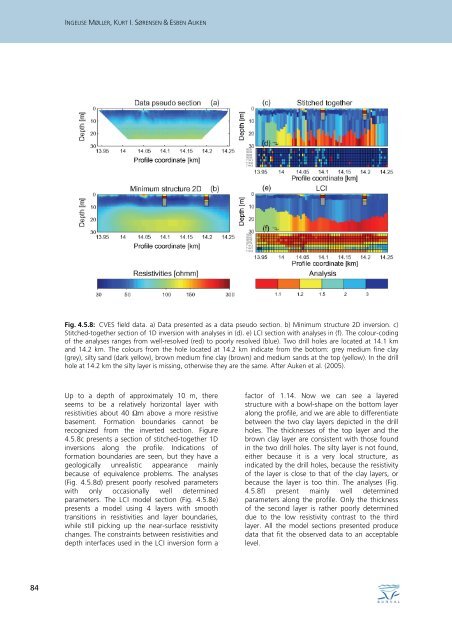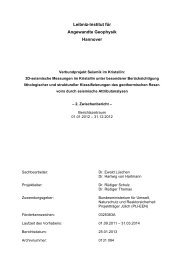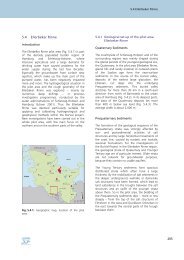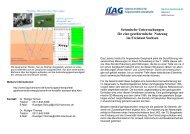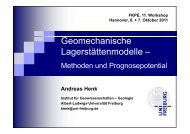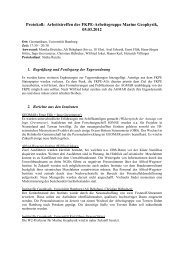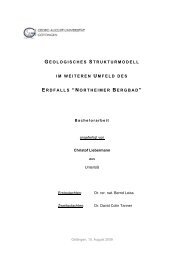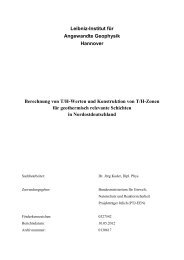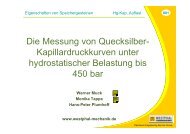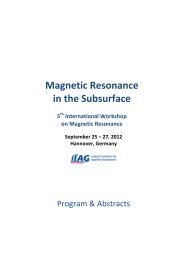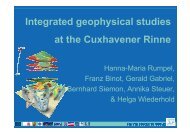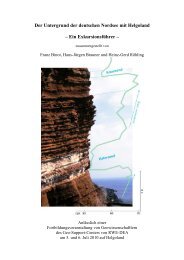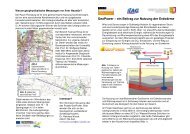4.5 Geoelectrical methods - LIAG
4.5 Geoelectrical methods - LIAG
4.5 Geoelectrical methods - LIAG
Create successful ePaper yourself
Turn your PDF publications into a flip-book with our unique Google optimized e-Paper software.
84<br />
INGELISE MØLLER, KURT I. SØRENSEN & ESBEN AUKEN<br />
Fig. <strong>4.5</strong>.8: CVES field data. a) Data presented as a data pseudo section. b) Minimum structure 2D inversion. c)<br />
Stitched-together section of 1D inversion with analyses in (d). e) LCI section with analyses in (f). The colour-coding<br />
of the analyses ranges from well-resolved (red) to poorly resolved (blue). Two drill holes are located at 14.1 km<br />
and 14.2 km. The colours from the hole located at 14.2 km indicate from the bottom: grey medium fine clay<br />
(grey), silty sand (dark yellow), brown medium fine clay (brown) and medium sands at the top (yellow). In the drill<br />
hole at 14.2 km the silty layer is missing, otherwise they are the same. After Auken et al. (2005).<br />
Up to a depth of approximately 10 m, there<br />
seems to be a relatively horizontal layer with<br />
resistivities about 40 Ωm above a more resistive<br />
basement. Formation boundaries cannot be<br />
recognized from the inverted section. Figure<br />
<strong>4.5</strong>.8c presents a section of stitched-together 1D<br />
inversions along the profile. Indications of<br />
formation boundaries are seen, but they have a<br />
geologically unrealistic appearance mainly<br />
because of equivalence problems. The analyses<br />
(Fig. <strong>4.5</strong>.8d) present poorly resolved parameters<br />
with only occasionally well determined<br />
parameters. The LCI model section (Fig. <strong>4.5</strong>.8e)<br />
presents a model using 4 layers with smooth<br />
transitions in resistivities and layer boundaries,<br />
while still picking up the near-surface resistivity<br />
changes. The constraints between resistivities and<br />
depth interfaces used in the LCI inversion form a<br />
factor of 1.14. Now we can see a layered<br />
structure with a bowl-shape on the bottom layer<br />
along the profile, and we are able to differentiate<br />
between the two clay layers depicted in the drill<br />
holes. The thicknesses of the top layer and the<br />
brown clay layer are consistent with those found<br />
in the two drill holes. The silty layer is not found,<br />
either because it is a very local structure, as<br />
indicated by the drill holes, because the resistivity<br />
of the layer is close to that of the clay layers, or<br />
because the layer is too thin. The analyses (Fig.<br />
<strong>4.5</strong>.8f) present mainly well determined<br />
parameters along the profile. Only the thickness<br />
of the second layer is rather poorly determined<br />
due to the low resistivity contrast to the third<br />
layer. All the model sections presented produce<br />
data that fit the observed data to an acceptable<br />
level.


